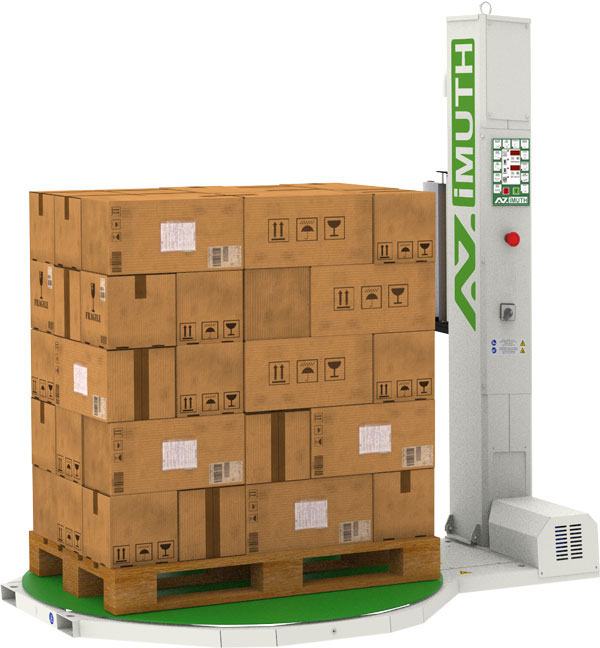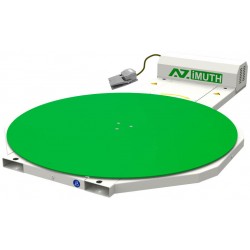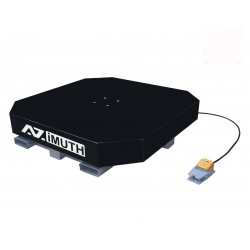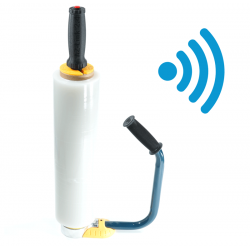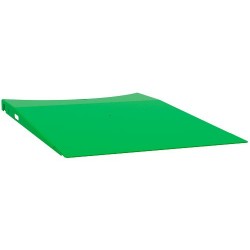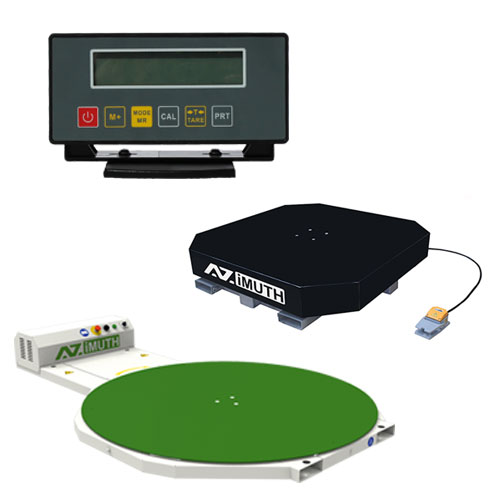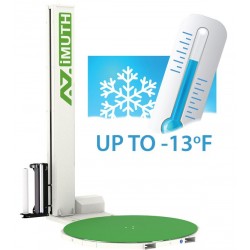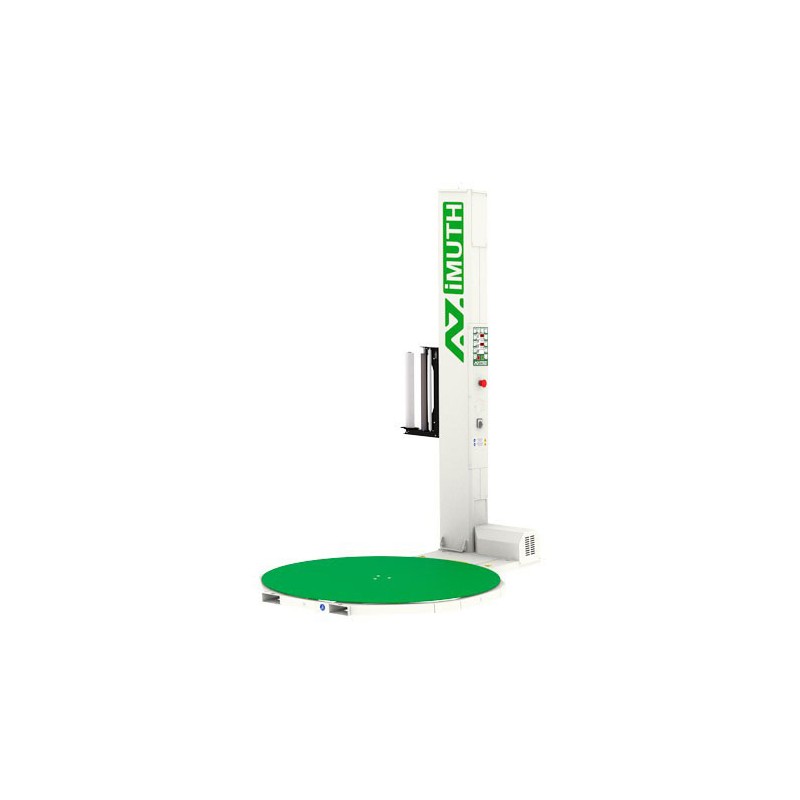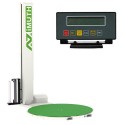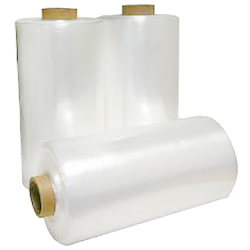AZIMUTH 3002 Low Profile Stretch Wrappers
The AZIMUTH-3002 Pallet Wrapping Machine - Best Price and Best Functionality
- The maximum amount of adjustment in the base.
- It's very easy to install simple to operate and virtually zero maintenance.
- Can be moved by Forklift at the Front and at the Rear side of Turntable.
- Digital control panel. Selection of 10 wrapping parameters and save it in the 99 programs.
- Max SKID Size: 50"x50"x125"
- Wrap Height: UP to 125"
- Load Capacity: up to 4 000 LBS
- Turntable Speed Adjustable: from 0 to 12 RPM
- Stretch Film Tension: manual, 20% - 160%
- Production Rate: 10-20 Loads Per Hour
- Turntable: 59" Round Smooth Top, Low profile, Chain Drive
- Use with Machine Stretch Wrap 3 in core Stretch Wrap rolls. Up to 20 in height
- Convenient photo eye - allow operator to walk away. Standard Photo Eye Sensor - reads loads 25 in or taller. May not work with red, blue and black surfaces (use Manual Mode or Mode with Present Height).
- Permitted Ambient Conditions: Indoor Usage only.
- Temperature: 41°F and above. To work below this temperature need to be FREEZER Version.
- Atmospheric Conditions: not greater than 50% at a temperature of 104°F and 90% at a temperature not over 68°F (without condensation)
- Color may very
- NO liftgate delivery
Control Panel Functions
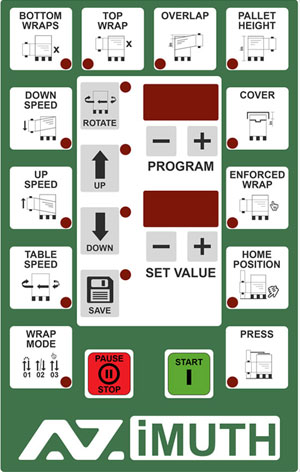
- Separate numbers of Enforced Wraps at bottom/top SKID.
- Adjusting the rotation speed of the Pallet Wrapper Turntable
- Customization SKID wrapping height (if necessary)
- Soft Start and Soft Stop at home position of Pallet Wrapper Turntable
- Setting the carret up/down moving speed
- 99 Customized Wrapping Programs Profiles memory
- Protection from change Wrapping Parameters
- Sound Signals at Start and End of Wrapping cycles
- Setting the upper Overlap the top of the cargo
- Function to wrap SKID using plastic or corrugated Top Cover
- Emergency Stop Button
- Active Compression Protection System
- Manual Wrapping Mode
Pallet Wrapper Dimensions
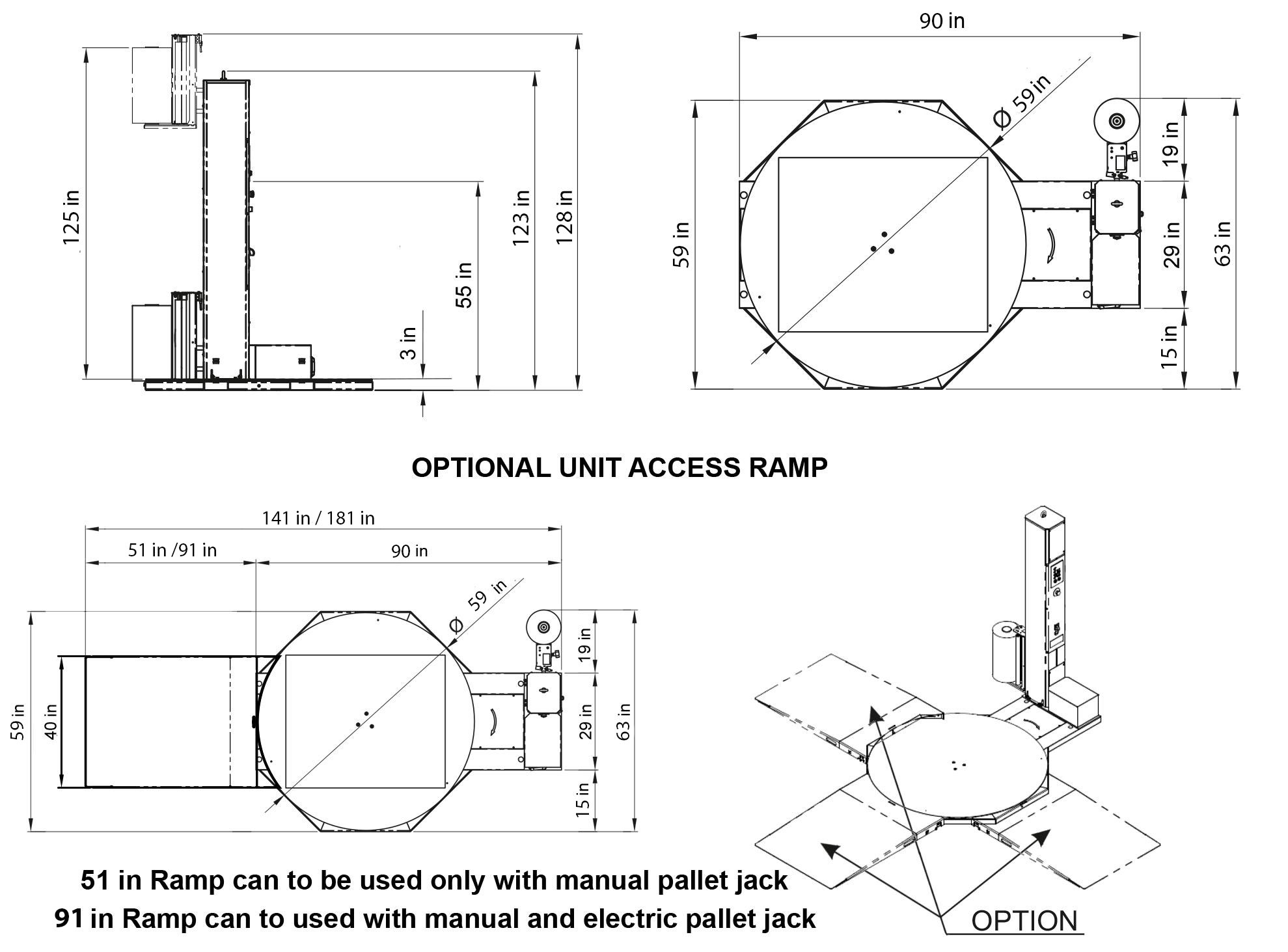
Pallet Wrapper: Pros and Cons
Pallet wrapper, also known as stretch wrapper, offer several advantages and disadvantages in packaging and logistics operations. Here's a breakdown of the pros and cons:
Pros:
- Load Stability: Pallet wrapper securely bind palletized loads with stretch film, preventing movement, toppling, or spillage during transportation and storage, thus preserving product integrity.
- Product Protection: Stretch film acts as a barrier against moisture, dust, and dirt, safeguarding goods throughout the supply chain, especially for sensitive items.
- Efficiency: Automated wrapping processes save time and labor, enabling swift and consistent wrapping of multiple pallets, enhancing overall productivity.
- Customization: Stretch wrapper offer adjustable settings such as film tension and wrapping patterns, allowing tailored wrapping for diverse load specifications.
- Cost Savings: Despite the initial investment, stretch wrapper yield long-term cost reductions by enhancing operational efficiency, decreasing labor expenses, and minimizing product damage.
- Space Optimization: Stretch wrapper maximize vertical storage by enabling efficient stacking of pallets, contributing to space utilization in warehouses and distribution centers.
- Safety: Equipped with safety features like emergency stops, stretch wrappers ensure a secure work environment for operators during the wrapping process.
- Versatility: Stretch wrapper accommodate various pallet sizes and configurations, offering flexibility in packaging solutions for different industries and applications.
Cons:
- Initial Investment: The purchase cost of stretch wrapper can be relatively high, especially for advanced models with integrated features such as weighing scales or automation.
- Maintenance Requirements: Stretch wrapper require regular maintenance to ensure optimal performance and longevity. This includes cleaning, lubrication, and periodic inspection of components.
- Training Needs: Operators need training to operate stretch wrapper safely and effectively. Improper use of the equipment can lead to damage to goods, injuries, or equipment malfunction.
- Film Waste: Excessive use of stretch film or improper application techniques can result in film waste, increasing packaging costs and environmental impact.
- Technical Issues: Like any machinery, stretch wrapper may experience technical issues such as film breaks, sensor malfunctions, or motor failures, which can disrupt operations and require prompt troubleshooting and repair.
- Dependency on Power: Automated stretch wrapper rely on electricity to operate, which can be a limitation in areas prone to power outages or in facilities with limited access to electrical outlets.
- Film Selection: Choosing the right type and thickness of stretch film is crucial for effective wrapping. Poor-quality film or incorrect film selection can compromise load stability and protection.
Overall, while stretch wrappers offer numerous benefits in terms of efficiency, product protection, and space optimization, they also come with certain drawbacks that need to be considered and managed effectively to maximize their utility and value in packaging and logistics operations.
Pallet Wrapper or Manual Wrapping?
Using a pallet wrapper is generally considered better than manual wrapping for several reasons, as it offers numerous advantages in terms of efficiency, consistency, and overall operational benefits. Here's why using a pallet wrapper is often preferred over manual wrapping:
- Efficiency:
- Time-Saving: Pallet wrapper automate the wrapping process, allowing for faster and more efficient wrapping of palletized loads. This significantly reduces the time required compared to manual wrapping, especially in high-volume operations.
- Consistency:
- Uniform Wrapping: Pallet wrapper apply stretch film with consistent tension and coverage, ensuring that each palletized load is wrapped uniformly. Manual wrapping may result in variations in tension and film application, leading to inconsistencies and potential load instability.
- Labor Savings:
- Reduced Physical Strain: Automated pallet wrapper eliminate the need for manual labor in the wrapping process. This reduces physical strain on workers, especially in situations where large or heavy loads need to be wrapped.
- Customization:
- Adjustable Parameters: Pallet wrapper offer adjustable parameters such as film tension, rotation speed, and wrapping patterns, allowing for customization based on the specific requirements of different palletized loads. Manual wrapping may not provide the same level of customization.
- Safety:
- Enhanced Operator Safety: Pallet wrapper often come with safety features such as emergency stops and safety barriers, contributing to a safer working environment for operators. Manual wrapping poses a higher risk of musculoskeletal injuries and strains to workers due to repetitive motions and heavy lifting.
- Cost-Effectiveness:
- Long-Term Savings: While there is an initial investment in pallet wrappers, the long-term savings in labor costs, increased efficiency, and minimized product damage can outweigh the upfront expenses.
- Optimized Film Usage:
- Film Stretch Technology: Pallet wrapper with pre-stretch technology optimize the usage of stretch film by elongating it before application. This results in greater coverage with less film, reducing material costs and environmental impact.
- Versatility:
- Accommodation of Various Loads: Pallet wrapper are designed to accommodate various pallet sizes, shapes, and load configurations. It provide versatility in packaging solutions, which may be challenging to achieve consistently with manual wrapping.
- Integration with Other Equipment:
- Automation Integration: Pallet wrapper can be integrated with other warehouse equipment, such as conveyors, forklifts, and automated systems, streamlining the entire packaging and logistics process.
In summary, using a pallet wrapper is advantageous over manual wrapping due to the significant improvements in efficiency, consistency, labor savings, and overall operational effectiveness. While the initial investment should be considered, the long-term benefits often outweigh the costs for businesses with regular or high-volume pallet wrapping needs.
Stretch Wrapper Using Process
Placing a pallet on a pallet wrapper involves a series of steps to ensure safety, stability, and efficiency. Here's a detailed process for placing a pallet on a wrapper:
- Preparation:
- Ensure the pallet wrapper is in a stable position and turned off.
- Clear the area around the pallet wrapper of any obstacles or debris.
- Verify that the pallet wrapper is set up correctly and ready for operation.
- Prepare the Pallet:
- Ensure the pallet is in good condition, free from damage or defects.
- Verify that the pallet is suitable for the products being wrapped and the size of the pallet wrapper.
- Position the Pallet Wrapper:
- Position the pallet wrapper in a location that allows for easy access and maneuverability around the equipment.
- Ensure there is enough space for loading and unloading pallets onto the wrapper.
- Align the Pallet:
- Position the pallet in front of the pallet wrapper, ensuring it is centered and aligned with the turntable or platform of the wrapper.
- Ensure the pallet is stable and level to prevent imbalance during the wrapping process.
- Load the Pallet onto the Wrapper:
- Use a forklift or pallet jack to lift the pallet and carefully place it onto the turntable or platform of the pallet wrapper.
- Make sure the pallet is positioned securely and centered on the turntable to ensure even wrapping.
- Secure the Pallet:
- Engage any locking mechanisms or safety features on the pallet wrapper to secure the pallet in place.
- Double-check to ensure the pallet is stable and properly secured before starting the wrapping process.
- Verify Wrapping Parameters:
- Check the wrapping parameters on the control panel of the pallet wrapper, including film tension, rotation speed, and wrapping patterns.
- Adjust the parameters as needed based on the specifications of the palletized load.
- Start the Wrapping Process:
- Initiate the wrapping process by activating the pallet wrapper according to the selected mode (manual, semi-automatic, or automatic).
- Monitor the wrapping process to ensure the stretch film is applied evenly and securely around the palletized load.
- Complete the Wrapping Process:
- Once the wrapping process is complete, stop the pallet wrapper and disengage any locking mechanisms or safety features.
- Carefully remove the wrapped pallet from the wrapper using a forklift or pallet jack, ensuring it is stable and secure.
- Unload the Wrapped Pallet:
- Transport the wrapped pallet to the desired location for storage or shipment, ensuring it is handled with care to prevent damage.
By following these steps, you can safely and efficiently place a pallet on a pallet wrapper, ensuring that palletized loads are securely wrapped for transportation and storage.
Pallet Wrapper with Scale
A scale wrapper, also known as a pallet wrapper with an integrated scale, combines the functions of a stretch wrapper with a built-in weighing system. This equipment is designed to weigh and wrap palletized loads in a single automated process. Here's an overview of how a scale wrapper typically functions:
- Weighing Process:
- The integrated scale is usually located within the turntable or platform of the pallet wrapper.
- The palletized load is placed on the turntable, and the weight is measured using the built-in scale. This process is automated and occurs as part of the overall wrapping operation.
- Adjustable Parameters:
- The scale wrapper provides adjustable parameters for the weighing process, allowing operators to set weight thresholds, units of measurement (pounds or kilograms), and other relevant parameters.
- Automated Wrapping:
- After the weighing process is completed, the automated wrapping process begins. The stretch film is dispensed and wrapped around the palletized load.
- The wrapper can be programmed to apply the stretch film according to specific parameters such as film tension, rotation speed, and wrapping patterns.
- Simultaneous Operation:
- The weighing and wrapping processes occur simultaneously, providing a seamless and efficient operation.
- The scale wrapper is equipped to handle both functions without the need for separate equipment or manual intervention.
- User Interface:
- Scale wrappers are typically equipped with a user-friendly interface or control panel. Operators can input parameters, start and stop the operation, and monitor the progress of both the weighing and wrapping processes.
- Safety Features:
- Like standard pallet wrappers, scale wrappers incorporate safety features such as emergency stops and safety barriers to ensure a secure working environment for operators.
- Weighing Accuracy:
- The integrated scale is designed to provide accurate weight measurements, ensuring compliance with shipping regulations and carrier requirements. This accuracy helps prevent fines or rejections due to inaccurate weight declarations.
- Versatility:
- Scale wrappers are versatile and can handle various pallet sizes, configurations, and types of loads. This adaptability makes them suitable for a range of industries and applications.
- Cost and Time Savings:
- Combining weighing and wrapping into a single automated process saves time and labor costs. It streamlines the packaging operation and eliminates the need for separate weighing equipment.
- Data Logging:
- Some scale wrappers may have data logging capabilities, recording weight measurements and wrapping parameters for quality control, inventory management, and traceability purposes.
Scale wrappers offer an integrated solution for businesses that require both accurate weighing and secure pallet wrapping. They contribute to efficiency, cost-effectiveness, and improved overall packaging operations.
| Max Skid Size | 50x50x125" |
| Wrap Height | Up to 125 in |
| Load Capacity | Up to 4 000 LBS |
| Turntable Speed | from 0 to 12 RPM |
| Stretch film Tension | Manual, 20% - 160% |
| Production Rate | Up to 20 Loads Per Hour |
| Turntable | 59 in Diameter, Round Smooth Top, Low profile, Chain Drive |
| Power Consumption | 115V, 15A |
| Machine Length | 90 in |
| Machine Height | 123 in |
| Type | Semi-Automatic |
| Stretch Wrap | 3 in core Stretch Wrap rolls. Up to 20 in height. Up to 35 lbs |
| Height Sensing | Standard Photo Eye Sensor - reads loads 25 in or taller. May not work with red, blue and black surfaces (use Manual Mode or Mode with Present Height). |
| Permitted Ambient Conditions | Indoor Usage only. |
| Temperature | between 41°F and 113°F. To work below 41°F need to be FREEZER Version. |
| Atmospheric Conditions | not greater than 50% at a temperature of 104°F and 90% at a temperature not over 68°F (without condensation) |
| Loading Option | Forklift or Pallet Jack (need Ramp Option) |
| Material | Steel |
| Package Size | 120 x 63 x 21" |
| Gross Weight | 950 lbs |
| Net Weight | 800 lbs |
| Color | Grey/Green (color may very) |
| Liftgate Delivery | NO |
| Warranty | 2 years |
| Positioning | May be mounting to the floor if needed |
| Review Count | 12 |
| Rating Value | 4.98 |
